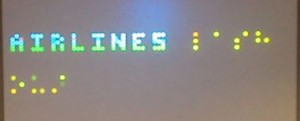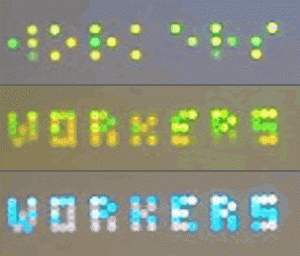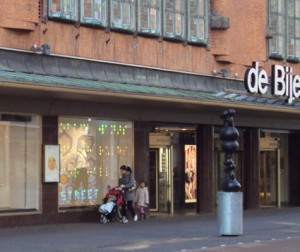Braille for the non-blind is an interactive installation that transforms braille into readable information. It lets you experience the wonderful sensation of hidden information being revealed by simply sliding your fingers over an unreadable code.
The installation consists of a touch sensitive white-board (‘Smartboard’) on which a message in braille is projected. When you touch a braille character, it turns into its readable counterpart, i.e. the letter it represents. By sliding your hand over the message, touching each braille character, the whole message becomes readable.
The message can be anything; in the current setup the system takes items from RSS feeds from news sites and refresh the message each 15 seconds. This way, the installation becomes a living wallpaper which is unobtrusive and nice to look at, even when no-one is interacting with it.
To tease people to come to the whiteboard and make the braille  message readable, the system reveals one word in the message by itself. Being able to read one word of the otherwise unreadable message makes people curious about the complete message and attracts them to the installation.
message readable, the system reveals one word in the message by itself. Being able to read one word of the otherwise unreadable message makes people curious about the complete message and attracts them to the installation.
 The colors become brighter as characters turn into readable format, switching from a color palette that a colorblind person experiences to one that is seen by a non-colorblind person.Touching a character for a second time, its color palette changes from colorblind to normal.
The colors become brighter as characters turn into readable format, switching from a color palette that a colorblind person experiences to one that is seen by a non-colorblind person.Touching a character for a second time, its color palette changes from colorblind to normal.
The setup of the system is as follows: an internet connected PC runs the software (Written in FLEX/actionscript). It retrieves a new list of messages from one or more RSS feeds every hour. From this list, every 15 seconds a message is randomly chosen and translated in braille. A projector is connected to the PC and projects the message on a touch-sensitive whiteboard, also connected to the PC. Everytime the board detects that it is touched, the software transform the braille character on the touched position to a normal character in a smooth animated transformation. The character is transformed back to normal after a fixed time (e.g. 30 seconds).
Instead of a touch sensitive whiteboard, ‘Braille for the non-blind’ can be displayed and interacted with on any touch sensitive screen, such as an iPod, iPad. It can also be extended with external sensors such that braille turns into normal characters when people walk by or just approach the screen, instead of having to actually touch it. This setup would make it suitable for display in shop-windows. People passing by make the braille turn into normal characters. Or, using distance sensors on the window, the characters change when people touch the window.


